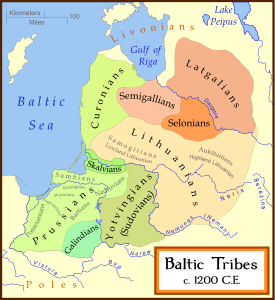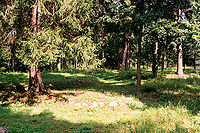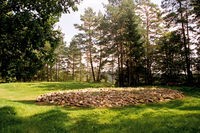
Yotvingians
Encyclopedia



Balts
The Balts or Baltic peoples , defined as speakers of one of the Baltic languages, a branch of the Indo-European language family, are descended from a group of Indo-European tribes who settled the area between the Jutland peninsula in the west and Moscow, Oka and Volga rivers basins in the east...
people with close cultural ties to the Lithuanians
Lithuanians
Lithuanians are the Baltic ethnic group native to Lithuania, where they number around 2,765,600 people. Another million or more make up the Lithuanian diaspora, largely found in countries such as the United States, Brazil, Canada, Colombia, Russia, United Kingdom and Ireland. Their native language...
and Prussians. The Yotvingian language
Sudovian language
Sudovian is an extinct western Baltic language of Northeastern Europe. Closely related to the Old Prussian language, it was formerly spoken southwest of the Nemunas river in what is now Lithuania, east of Galindia and north of Yotvingia, and by exiles in East Prussia.-History:Sudovia and...
(sometimes called Sudovian) was a Western Baltic language nearest to Prussian, but with small variations.
Geography
Yotvingians lived in the area of SudoviaSudovia
-In geography:* Sudovia/Yotvingia, ancient Baltic land inhabited by Sudovians/Yotvingians* Suvalkija, one of the five cultural regions of Lithuania* Suwałki Region, region in Poland near the border with Lithuania-In sport:...
and Dainava
Dainava
Dainava may refer to:*Dainava an alternative name for Dzūkija, Lithuanian region,*Dainava an elderate in Kaunas city....
(Yotvingia
Yotvingia
Yotvingia was a region where the Baltic tribe known as Yotvingians lived. It was located in the area of Sudovia and Dainava; south west from the upper Neman, between Marijampolė, Merkinė , Slonim, Kobryn , Białystok, and Ełk ;...
); south west from the upper Neman
Neman River
Neman or Niemen or Nemunas, is a major Eastern European river rising in Belarus and flowing through Lithuania before draining into the Curonian Lagoon and then into the Baltic Sea at Klaipėda. It is the northern border between Lithuania and Russia's Kaliningrad Oblast in its lower reaches...
and their land began to be conquered by various people. The territory was between later Marijampolė
Marijampole
Marijampolė is an industrial city and the capital of the Marijampolė County in the south of Lithuania, bordering Poland and Russian Kaliningrad oblast, and Lake Vištytis. The population of Marijampolė is 48,700...
, Merkinė
Merkine
Merkinė is a town in Dzūkija National Park in Lithuania, located at the confluence of the Merkys and Neman Rivers.First mentioned in 1359, Merkinė is one of the oldest Lithuanian settlements. It received the Magdeburg rights in 1569. The town is the location of The Mount of Queen Bona, a mound...
(Lithuania
Lithuania
Lithuania , officially the Republic of Lithuania is a country in Northern Europe, the biggest of the three Baltic states. It is situated along the southeastern shore of the Baltic Sea, whereby to the west lie Sweden and Denmark...
), Slonim
Slonim
Slonim is a city in Hrodna Voblast, Belarus, capital of the Slonim District. It is located at the junction of the Shchara and Isa rivers, 143 km southeast of Hrodna. The population in 2008 was 50,800.-Etymology and historical names:...
, Kobryn
Kobryn
Kobryn or Kobrin is a city in the Brest voblast of Belarus and the center of the Kobryn Raion. The city is located in the southwestern corner of Belarus where the Mukhavets River and Dnepr-Bug Canal meet. The city lies about 52 km east of the city of Brest. Kobryn is located at Latitude...
(Belarus
Belarus
Belarus , officially the Republic of Belarus, is a landlocked country in Eastern Europe, bordered clockwise by Russia to the northeast, Ukraine to the south, Poland to the west, and Lithuania and Latvia to the northwest. Its capital is Minsk; other major cities include Brest, Grodno , Gomel ,...
), Białystok, and Ełk (Poland
Poland
Poland , officially the Republic of Poland , is a country in Central Europe bordered by Germany to the west; the Czech Republic and Slovakia to the south; Ukraine, Belarus and Lithuania to the east; and the Baltic Sea and Kaliningrad Oblast, a Russian exclave, to the north...
). Vytautas the Great wrote about "terra Sudorum", in a letter to King Sigismund of March 11, 1420. Today this area corresponds mostly to the Podlaskie Voivodeship
Podlaskie Voivodeship
Podlaskie Voivodeship , is a voivodeship in northeastern Poland. It borders on Masovian Voivodeship to the west, Warmian-Masurian Voivodeship to the northwest, Lublin Voivodeship to the south, the Belarusssian Voblasts of Grodno and Brest to the east, the Lithuanian Counties of Alytus and...
of Poland
Poland
Poland , officially the Republic of Poland , is a country in Central Europe bordered by Germany to the west; the Czech Republic and Slovakia to the south; Ukraine, Belarus and Lithuania to the east; and the Baltic Sea and Kaliningrad Oblast, a Russian exclave, to the north...
, portions of Lithuania
Lithuania
Lithuania , officially the Republic of Lithuania is a country in Northern Europe, the biggest of the three Baltic states. It is situated along the southeastern shore of the Baltic Sea, whereby to the west lie Sweden and Denmark...
and a part of Hrodna Province of Belarus
Belarus
Belarus , officially the Republic of Belarus, is a landlocked country in Eastern Europe, bordered clockwise by Russia to the northeast, Ukraine to the south, Poland to the west, and Lithuania and Latvia to the northwest. Its capital is Minsk; other major cities include Brest, Grodno , Gomel ,...
.
Name
The name Sūduva, according to Vytautas MažiulisVytautas Mažiulis
Vytautas Mažiulis was a highly distinguished Lithuanian Balticist, an expert on the Old Prussian language and Indo-European languages.-Biography:...
("Prūsų kalbos etimologijos žodynas", "Etymological Dictionary of Prussian Language"), derives from a local hydronym "*Sūd(a)vā", in turn derived from a Baltic language verbal root "*sū-": to flow, pour.
History
According to The Histories of HerodotusHerodotus
Herodotus was an ancient Greek historian who was born in Halicarnassus, Caria and lived in the 5th century BC . He has been called the "Father of History", and was the first historian known to collect his materials systematically, test their accuracy to a certain extent and arrange them in a...
(5th century B.C.), the Neuri
Neuri
According to Herodotus the Neuri were a tribe living beyond the Scythian cultivators, one of the nations along the course of the river Ὕπανις Hypanis , West of the Βορυσθένης Borysthenes , roughly the area of modern Belarus and Eastern Poland.-Herodotus's Account:In Herodotus's account, he states...
( Νέυροι ) were a tribe living beyond the Scythian cultivators, one of the nations along the course of the river Hypanis
Hypanis
Hypanis may refer to:* The Ancient Greek name of the Southern Bug river in Southern Ukraine* The Ancient Greek name of the Kuban River in Southern Russia.* Hypanis , a genus of cockles...
(Bug river), west of the Borysthenes
Borysthenes
Borysthenes is a geographical name from classical Antiquity. It usually refers to the Dnipro River, but occasionally to the Pontic Olbia, a town situated at the mouth of that river. The Borysthenes is mentioned numerous times in 'The History of the Decline and Fall of the Roman Empire' by Edward...
(Dniepr river). Roughly the area of modern Belarus and Eastern Poland by the Narew
Narew
The Narew River , in western Belarus and north-eastern Poland, is a left tributary of the Vistula river...
river - which coincides with the Yotvingian linguistic territory of toponyms and hydronyms (Narew
Narew
The Narew River , in western Belarus and north-eastern Poland, is a left tributary of the Vistula river...
river).
Ptolemy
Ptolemy
Claudius Ptolemy , was a Roman citizen of Egypt who wrote in Greek. He was a mathematician, astronomer, geographer, astrologer, and poet of a single epigram in the Greek Anthology. He lived in Egypt under Roman rule, and is believed to have been born in the town of Ptolemais Hermiou in the...
in the 2nd century AD called the people Galindai kai Soudinoi (Σουδινοί). Peter von Dusburg called them Galindite and Suduwite. In the Hypatian Codex
Hypatian Codex
The Hypatian Codex is a compendium of three chronicles: the Primary Chronicle, Kiev Chronicle, and Galician-Volhynian Chronicle. It is the most important source of historical data for southern Rus'...
the spellings are changing: Jatviagy, Jatviezie, Jatviažin, zemlia Jatveskaja, na zemliu Jatviažs´kuju and more. Polish sources used also Russian spellings: Jazviagi, Iazvizite, Jazvizite, Yazvizite. In the treaty with the Teutonic Knights in 1260 the region is called "terre Getuizintarum". This name was taken by the papal administration: terra Jatwesouie, Gretuesia, Gzestuesie, Getuesia und Getvesia. The Knights called this tribe Sudowite, Sudowia, in qua Sudowit.
The names Yotvingians and Sudovians are never mentioned at the same time, so that both names must refer to the same tribe. In the sentence of Breslau of the emperor Sigismund of Luxembourg to the Order of Livland from 1325 it is called Suderlandt alias Jetuen. In two dotations (1253 and 1259) of Mindaugas
Mindaugas
Mindaugas was the first known Grand Duke of Lithuania and the only King of Lithuania. Little is known of his origins, early life, or rise to power; he is mentioned in a 1219 treaty as an elder duke, and in 1236 as the leader of all the Lithuanians...
I. a new name was published: Dainava, Deynowe, Dainowe, Denowe (land of songs). Also named were the forests Deinova Jatvež.
A census by the clergy of the Belarus Grodno area in 1860 had as many as 30,929 inhabitants identifying themselves as Yatviags.
Genetic
A genetic portrait of modern Belarusians documents A separation of subpopulations along the south-north line, which is demonstrated particularly in distribution of Y chromosomalY chromosome
The Y chromosome is one of the two sex-determining chromosomes in most mammals, including humans. In mammals, it contains the gene SRY, which triggers testis development if present. The human Y chromosome is composed of about 60 million base pairs...
lineages R1b
Haplogroup R1b (Y-DNA)
The point of origin of R1b is thought to lie in Eurasia, most likely in Western Asia. T. Karafet et al. estimated the age of R1, the parent of R1b, as 18,500 years before present....
, I1a and I1b, N3
Haplogroup N (Y-DNA)
In human genetics, Haplogroup N is a Y-chromosome DNA haplogroup, defined by the presence of the marker M231. The b2/b3 deletion in the AZFc region of the human Y-chromosome is a characteristic of Haplogroup N haplotypes. This deletion, however, appears to have occurred independently on four...
and G
Haplogroup G (Y-DNA)
In human genetics, Haplogroup G is a Y-chromosome haplogroup. It is a branch of Haplogroup F . Haplogroup G has an overall low frequency in most populations but is widely distributed within many ethnic groups of the Old World in Europe, northern and western Asia, northern Africa, the Middle East,...
-chromosomes, has been noted; east-west gradient is insignificant.
The results of genetic structure analyses suggest "that Russians from Velikiy Novgorod area (northwestern Russia) and Poles from Suwalszczyzna (northeastern Poland) differ from all remaining Polish and Russian samples".
Historical persons
- SkalmantasSkalmantasSkomantas/Komantas is a name of:*Skomantas of Sudovia, last tribal leader and pagan priest of the Sudovians/Yotvingians*Skalmantas , presumed ancestor of the Gediminids dynasty...
, leader of Sudovians, took part in the Prussian uprisingsPrussian uprisingsThe Prussian uprisings were two major and three smaller uprisings by the Prussians, one of the Baltic tribes, against the Teutonic Knights that took place in the 13th century during the Northern Crusades. The crusading military order, supported by the Popes and Christian Europe, sought to conquer...
.
Monuments
The horse- Per nedėlę žirgužį szėrau
- Subatoje po pietu sawo bėrą žirgėlį gražei szropawau.
Flowers
- Sėjau rutas, sėjau mėtas
- sėjau szwėses lėlijates
- sėjau žalius lewendrelus.
The lover
- Atsimįk bernužėli
- Ką wakar kalbėjai
- Karcziamėlij už stalėlio, rankėles sudėjai.
Dancing animals
- Szoka kiszkis, szoka lapė, szoka wisi žwėris
- ir tas briedis, il garietis , ir tas ne tylėju.
Literature
- Marija Gimbutas, The Balts. London : Thames and Hudson, Ancient peoples and places 33, 1963.
- Totoraitis, J., Sūduvos Suvalkijos istorija. Marijampolė: Piko valanda.(2003) [1938] ISBN 9986875870.
- Witczak, K. T., Traces of Dual Forms in Old Prussian and Jatvingian in Woljciech Smoczynski and Axel Holvoet, eds, Colloquium Pruthenicum primum, 1992, pp 93–98
- Gerullis, G., Zur Sprache der Sudauer-Jadwinger, in Festschrift A. Bezzenberger, Göttingen 1927
- Toporov,V., ИНДОЕВРОПЕЙСКЕ ЯЗЫКИ [Indo-European languages] Лингвистический энциклопеический словарь.[Linguistic encyclopedic dictionary] Мoskva, 1990, pp 186–189
- Mažiulis, V., Baltic languages. Britannica Online Encyclopedia
- Henning, E., De rebus Jazygum sive Jazuin-gorum, Regiomonti, 1812
- Sjoegren, A., Ueber die Wohnsitz Verhaeltnisse und der Jatwaeger, St. Petersburg, 1859
- Sembrzycki, J., Die Nord-und Westgebiete the Jadwinger und deren Grenzen, Altpreussischeme Monatschrift, XXVIII, 1891, pp. 76-89
- W. R. Schmalstieg, Studies in Old Prussian, University Park and London, 1976.
- V. Toporov, Prusskij jazyk: Slovar, A - L, Moskva, 1975-1990.
- V. Mažiulis, Prūsų kalbos etimologijos žodynas, Vilnius, t. I-IV, 1988-1997.
- Archäologie der UDSSR: Die Finno-Ugrier und die Balten im Mittelalter, Teil II, Balten, S. 411-419, Moskau 1987
- Lepa, Gerhard (Hrsg): Die Sudauer, in Tolkemita-Texte Nr. 55, Dieburg 1998
- Lepa, Gerhard: Gedanken über die Prußen und ihre Lieder, in Tolkemita-Texte „25 Lieder der Sudauer“ Nr. 56, Dieburg 1999
- Litauische Enzyklopädie, Bd. XXVX, Boston, USA, 1963
- Salemke, Gerhard: Lagepläne der Wallburganlagen von der ehemaligen Provinz Ostpreußen, Gütersloh, 2005, Karten 19/ 7 - 19/ 13
- Žilevičius, Juozas: Grundzüge der kleinlitauischen Volksmusik, in Tolkemita-Texte „25 Lieder der Sudauer“ Nr. 56, Dieburg 1999

